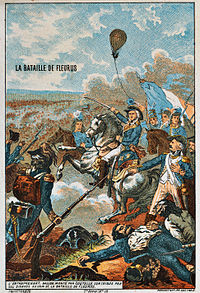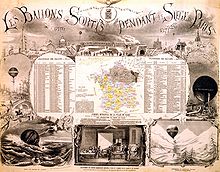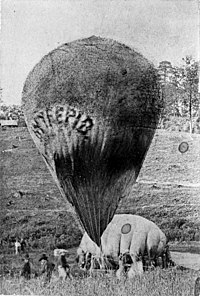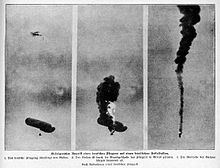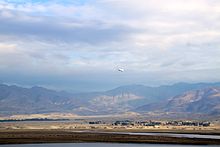History of military ballooning
Balloons provided a reliable and stable means of elevating an observer high over the battlefield to obtain a birds-eye view of troop positions and movements.
During the Cold War, the United States sent hundreds of high-altitude balloons over Eastern Bloc countries to gather intelligence on their nuclear capabilities, before replacing them with its newer spy planes.
They were rigid-style spheres made of cotton or silk stretched over a simple light wood frame resembling a large egg.
[3] In 1854, French aeronaut Eugène Godard performed several manned balloon demonstrations at the wedding of Austrian Emperor Franz Joseph I.
The Emperor was so impressed that he drafted an agreement with the Godard stating that in the event of a war, he would build balloons, organize balloonists companies, and perform observation ascents for the Austrian military.
General Irvin McDowell, commander of the Army of the Potomac, realized their value in aerial reconnaissance and had Lowe, who at the time was using his personal balloon the Enterprise, called up to the First Battle of Bull Run.
The trip began after inflation in Washington, D.C. and turned into a 12 mile (19 km), 12-hour excursion that was upended by a gale-force wind which ripped the aerostat from its netting and sent it sailing to the coast.
They were forced to fashion their balloons from colored silk dress-making material, and their use was limited by the infrequent supply of gas in Richmond, Virginia.
The first assignment for tethered military balloons was given to the Union Army's Corps of Topographical Engineers for mapmaking, and observation of enemy troops as early as 1850.
General Irvin McDowell, commander of the Army of the Potomac, called on the balloon to perform aerial observations of enemy encampments and movements in the First Battle of Bull Run.
With Lowe's techniques proven to the top commanders, he was eventually tasked to build seven balloons and a series of hydrogen gas generators to inflate them in the battlefield.
Even though Thaddeus Lowe was Chief Aeronaut, his bitter rival John La Mountain is credited with having made the first aerial observations of intelligence value while stationed independently at Fortress Monroe.
Prof. Lowe was once approached by the young Graf Ferdinand von Zeppelin in 1863, who was at the time acting as a then-civilian observer for the Union Army, about possibly serving as an aerial observer with Lowe, but this was forbidden by Union military authorities during the Civil War years, due to von Zeppelin's then-civilian status.
The future rigid airship pioneer was instead directed to the camp of John Steiner, a German aeronaut already in the United States, to get his first flight experience in a balloon, which von Zeppelin was able to do at a slightly later time while he still was in the US.
Lowe went on to make observations at Fair Oaks, Sharpsburg, Vicksburg and Fredericksburg before political ambush both from within the military and in Congress forced him to resign in April 1863 at which point he returned to the private sector.
On 6 July 1867, during the Paraguayan War, observation balloons were used by Brazil, assisted by the Allen brothers, James and Ezra, after their aerial intelligence pioneering for the Union army.
In July 1863 experimental balloon ascents for reconnaissance purposes were conducted by the Royal Engineers on behalf of the British Army, but although the experiments were successful it was considered not worth pursuing further because it was too expensive.
[13] By this time the limitations imposed by the need to produce hydrogen in the field by some portable apparatus and finding a suitable material for the envelope of a war balloon had been resolved.
It moved to Stanhope Lines, Aldershot in 1890 when a balloon section and depot were formed as permanent units of the Royal Engineers establishment.
[16][17][18][19] On October 5, 1907, Colonel John Capper (late Royal Engineers) and team flew the military airship Nulli Secundus from Farnborough around St. Paul's Cathedral in London and back with a view to raising public interest.
Positioning artillery observers on balloons, generally a few miles behind the front lines and at altitude, allowed them to see targets at greater range than they could on the ground.
The most successful were known as balloon busters, including such notables as Belgium's Willy Coppens, Germany's Friedrich Ritter von Röth, America's Frank Luke, and the Frenchmen Léon Bourjade, Michel Coiffard and Maurice Boyau.
[23] Barrage balloons, widely known as "blimps," were used by the United Kingdom to intercept air attacks by German bombers and V-1 cruise missiles.
The US government called for a press blackout on all balloon incidents, fearing what might happen if the Japanese started using fu-go to deliver biological weapons.
[25] Disguised as meteorological research, it launched hundreds of surveillance balloons that flew over China, Eastern Europe, and the Soviet Union to take photographs and collect intelligence.
[30] To increase effectiveness and minimize diplomatic blowback, it replaced the balloons with the newly developed U-2 reconnaissance plane, which was believed to be more difficult to detect.
[31] Since 1996, the United States has invested over $2 billion in Joint Land Attack Cruise Missile Defense Elevated Netted Sensor System or JLENS, which built aerostats to track low-altitude targets.
[35] Funded under project COLD STAR (Covert Long-Dwell Stratospheric Architecture) by the Pentagon, the balloons are stealthy, navigate using AI, and can harvest complex data.
[36] Tom Karako, a fellow at the Center for Strategic and International Studies, said the balloons can serve as communication and datalink nodes, as trucks for intelligence, surveillance and reconnaissance (ISR) to track airborne targets, and as platforms for various weapons.
[35] Around the same time, DARPA and several defense contractors were working on the Adaptable Lighter-Than-Air (ALTA) program,[37] which aimed to make stratospheric balloon navigation more precise and reliable using doppler laser.
